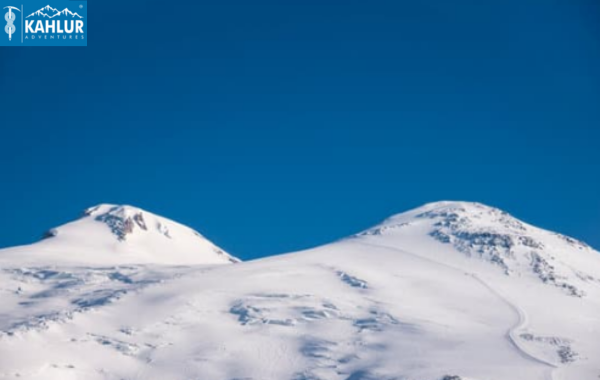
Mount Elbrus, standing majestically at 5642 meters (18,510 feet), is the highest peak in Europe and one of the coveted Seven Summits. Located in the Western Caucasus Mountain Range of Russia, this dormant volcano presents a formidable challenge to climbers and adventurers from around the globe. The twin-peaked mountain, with its Western summit towering over its slightly shorter Eastern twin, offers breathtaking vistas, rigorous climbs, and a profound sense of accomplishment upon reaching the summit.
Geography and Climate
Mount Elbrus is situated in the Caucasus Mountains, which form the natural border between Europe and Asia. The region experiences a continental climate, characterized by long, cold winters and short, cool summers. The mountain itself is perpetually covered in snow, with glaciers flowing down its slopes, making it a year-round climbing destination. Climbers must be prepared for sudden weather changes, sub-zero temperatures, and high winds, particularly as they ascend above the 5000-meter mark.
Historical Significance and Mythology
Mount Elbrus holds a significant place in both history and mythology. According to Greek mythology, the Titan Prometheus was chained to Mount Elbrus by Zeus as punishment for stealing fire and giving it to humanity. Historically, the mountain has been a site of cultural and strategic importance, with numerous expeditions attempting its summit over the centuries. The first successful ascent was made in 1874 by a British expedition led by F. Crauford Grove.
Routes to the Summit
There are several routes to the summit of Mount Elbrus 5642M, each varying in difficulty and popularity:
- South Route: The most popular and accessible route, starting from the Azau Valley. It offers infrastructure such as cable cars and ski lifts, making it a preferred choice for guided tours and less experienced climbers. Key points include the Barrels Huts and the Diesel Hut.
- North Route: Known for its remoteness and more challenging terrain, the North Route starts from the Kislovodsk region and offers a more isolated and rugged climbing experience. This route is less frequented, providing a sense of solitude and adventure.
- West and East Routes: These routes are less common and more demanding, requiring advanced climbing skills and often undertaken by experienced mountaineers seeking a unique challenge.
Preparation and Training
Climbing Mount Elbrus 5642M requires meticulous preparation and training. Key aspects include:
- Physical Fitness: High-altitude climbing demands exceptional cardiovascular endurance, strength, and stamina. A rigorous training regime focusing on aerobic exercises, strength training, and hiking is essential.
- Acclimatization: Proper acclimatization is crucial to avoid altitude sickness. Climbers should follow a schedule that allows for gradual ascent, including rest days and lower altitude hikes.
- Gear and Equipment: Essential gear includes high-quality climbing boots, crampons, ice axes, harnesses, and appropriate clothing for extreme cold. Ensure all equipment is tested and suitable for high-altitude conditions.
- Guided Tours and Permits: While experienced climbers may choose to go unguided, hiring a reputable guide service can enhance safety and provide valuable local knowledge. Permits are required for climbing, which can be obtained through authorized agencies.
Safety Considerations
Safety is paramount when climbing Mount Elbrus. Key considerations include:
- Weather Monitoring: Constantly monitor weather forecasts and be prepared for rapid changes. Summit attempts should be planned for periods of stable weather.
- Altitude Sickness: Be vigilant for symptoms of altitude sickness, such as headaches, nausea, and dizziness. Descend immediately if symptoms worsen.
- Crevasse Navigation: The glaciers on Mount Elbrus are riddled with crevasses. Use proper roping techniques and always travel with a partner or group.
- Emergency Protocols: Know the location of rescue stations and have a clear plan for emergency evacuation if necessary.
Cultural and Natural Attractions
The region surrounding Mount Elbrus is rich in cultural and natural attractions. Explore the picturesque Baksan Valley, visit the historic Prielbrusye National Park, and experience the warm hospitality of the local Balkar and Karachay communities. The region is also home to diverse flora and fauna, including rare species such as the Caucasian tur and the snow leopard.
Summit Day and Descent
The summit day is the culmination of the climb, often beginning in the early hours before dawn. Climbers typically set off from the Diesel Hut or the Barrels Huts, navigating through snowfields and past the Pastukhov Rocks. The final ascent to the Western summit involves steep, icy slopes and requires careful navigation and stamina. Upon reaching the summit, climbers are rewarded with panoramic views of the Caucasus range and a profound sense of achievement.
The descent follows the same route and requires caution to avoid accidents, particularly when fatigued. It is advisable to descend to lower altitudes promptly to facilitate recovery.
Post-Climb Activities
After the climb, take time to relax and celebrate your achievement. The local towns of Terskol and Cheget offer cozy accommodations, traditional cuisine, and opportunities to unwind. Consider exploring further afield in the Caucasus region, known for its stunning landscapes and cultural heritage.
Conclusion
Conquering Mount Elbrus is a remarkable achievement, demanding preparation, resilience, and respect for the mountain’s challenges. Whether you are an experienced mountaineer or a novice climber, the journey to the summit of Europe’s highest peak with Kahlur Adventures is a transformative experience that leaves lasting memories and a deep appreciation for the natural world.